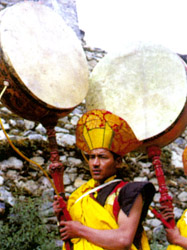Source: Tibet.cn
04-30-2008 20:27
Tibetan funerals have following features:
 |
| The Lama in the Gandain Monastery |
(l) Heavily influenced by natural environment: Distribution and evolvement of different funeral practices vest very much in the natural conditions of the areas. That is, in the places Where the forest resources are short, celestial burial will be Predominantly adopted, while cremation will be less practiced. In the dense woods area in Southeastern Tibet, cremation Mils. In the places full of gullies or torrential rivers, water burial will be treated equally with celestial burial.
(2) Deeply influenced by Tibetan Buddhism. The concept, ceremony, rituals and practices of funerals have changed greatly since the introduction of the Tibetan Buddhism. Influenced by such Buddhist concepts as transmigration or rebirth, the aboriginal inhumation practices have been gradually eliminated. For smoother transmigration, there should be no trace left of earthiness. The body is no exception and should be thoroughly disposed of--- either eaten by fish and vultures or incinerated.... As for the eminent monks, who themselves are incarnated, need not go through the procedures of rebirth like the commoners. So the grand living Buddhas like the Dalai Lama or the Panchan Lama will be well treated with stupa funerals. In conclusion, the history of the Tibetan funeral customs can be divided in two parts, with the later part being strongly influenced by Buddhism.
(3) All manner of funeral practices are used in Tibet. Besides the five main ways, namely celestial burial, inhumation or entombment, water burial, incineration or cremation and mummified or Preserved stupa burial, etc, there also exist other ways, such as cliff burial, tree burial, multi-person burial and stone coffin burial, etc. This nearly includes all funeral practices existing in the world.
Editor:Du Xiaodan
